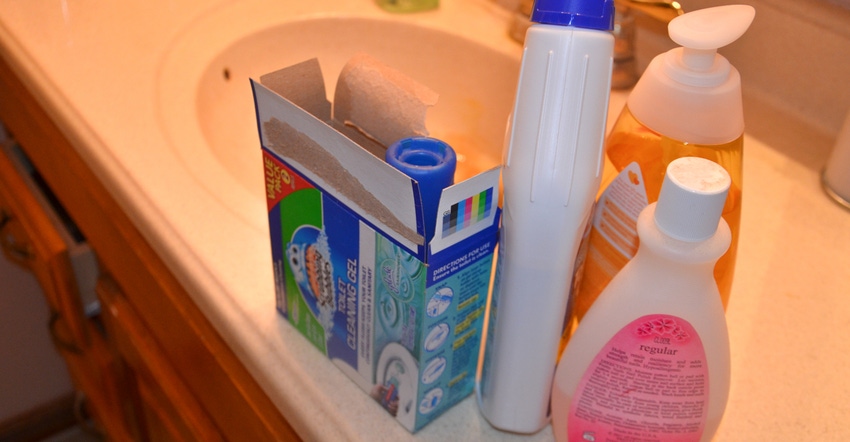
Livestock operations are always the first to draw blame when a pollution problem in a nearby stream arises. The assumption is that E. coli and nitrates came from a leaking lagoon or improperly spread manure. The truth is that sometimes the problem has nothing to do with livestock and everything to do with septic systems that either weren’t installed properly or weren’t managed correctly.
“Septic systems which fail contribute to problems with contaminants in streams,” says Gary Steinhardt, Purdue University Extension soil scientist. He prepares material to help installers and homeowners do a better job of making sure septic systems function properly.
Sept. 16-20 is national SepticSmart Week, designated by EPA. Steinhardt says it’s a good time to review how to keep your septic system functioning correctly.
Here are 12 things you don’t want in your septic system. Steinhardt calls them the “dirty dozen.”
1. Personal care products. Microbes in a septic tank can’t readily break down bath and body oils. Also, avoid cleansers and scrubs containing microbeads, which are tiny balls of plastic. They can reach septic fields and clog soil pores.
2. Cooking fats, oils and flour. The typical home on-site sewage system will struggle to deal with a large volume of cooking and baking products, Steinhardt says.
3. Solid waste. Using a garbage disposal that empties into the sewage line shortens septic tank cleaning intervals by 30%, Steinhardt says. Other items, such as disposable wipes, flushable or not, impede proper function of septic systems.
4. Dishwashing soap. Liquid dishwashing soaps are more septic-system friendly than powdered soaps. Products that make grease more soluble means more nondegraded grease passes into the septic field.
5. Laundry products. Using too much bleach or undiluted bleach can result in a “dead” septic tank with few bacteria. Bleach used at a reasonable level on a limited basis is acceptable. Fabric softeners added to the washing machine dissolve sludge at the bottom of the tank and result in more organic matter in the septic field.
6. Disinfectant cleaners. Cleaners classified as disinfectants are toxic to anaerobic bacteria. Use products like household ammonia at labeled rates and avoid dumping large amounts of disinfectants all at once. Avoid “every flush” toilet bowl cleaners.
7. Drain cleaners. Avoid excessive and frequent use of drain cleaners. Used according to label directions, they shouldn’t cause harm because microbe populations can rebuild quickly.
8. Organic solvents. Solvents such as paint thinner, antifreeze and charcoal lighter fluid are very toxic. Just because a sink is in the garage doesn’t mean it isn’t connected to your septic system.
9. Paint. Microbes can’t break down oil-based or latex paint. Excessive paint flushing means more frequent cleaning and possible system failure.
10. Heavy metals. These enter from older plumbing or lead-based paints. Many cosmetics and shampoos contain them in small amounts. They usually remain in sludge but become an issue if your septic system fails and deposits raw effluent into a waterway.
11. Pharmaceuticals. Never flush drugs, Steinhardt says. Medications are persistent in the environment. It’s even an issue for people taking cancer treatments, because those drugs pass through and kill microbes in the septic system.
12. Certain waste. Vomit contains undigested food. If you flush it often due to prolonged illness, it could become an issue.
About the Author(s)
You May Also Like




